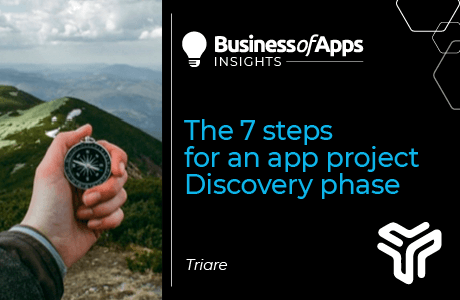
Startup companies and novel projects have a much broader range of opportunities in comparison to any other time in history. At the same time, the levels of competition have also increased substantially, bringing even more significance to every project detail. For example, McKinsey suggests that 17% of IT projects fail and threaten the existence of the company attempting their implementation.
In this light, the Discovery phase of any project becomes particularly essential. Its understanding, as well as a structured approach towards its implementation and execution, help with risk mitigation and avoiding the most common mistakes.
Key points:
- The Discovery stage helps with understanding the project from various standpoints
- 7 Discovery stage steps contribute to the quality of the completed work
- Avoiding or skipping the Discovery stage will still require the implementation of its components at higher costs to the project/company.
The definition of Discovery phase
Any project consists of five stages, including initiation, planning, execution, control, and closure. The discovery phase precedes these stages with the collection and analysis of information about the project, including its potential target market. Such a scoping process supports understanding of the project’s potential, limitations, and goals. At the same time, the Discovery allows understanding the needs and requirements of the end-users.
The duration of the Discovery phase ranges between 2 weeks as the most common timeframe, to 2 months for the most complex projects. Project managers, business analysts, account managers, developers, team leads, and designers may join the Discovery phase. The cost model for the phase may use fixed compensation packages or hourly rates as a basis.
The 7 Discovery steps that matter
While the duration of the Discovery phase varies depending on the project complexity, its structural elements remain the same:
- Definition of the stakeholders. The step involves creating a clear list including the parties that would be creating or using the finished product. This list may contain developers, product owners, investors, managers, and administrators.
- Communication with the stakeholders. This step implies direct communication with the stakeholders until the product owner understands the product vision completely. The step also includes the discovery session questions to avoid any ambiguity. The project team confirms access to all of the needed parties to ensure project completion.
- Review of the internal documents and existing research. Business analyst reviews and analyses relevant materials to assess the existing solutions and approaches. Conversely, it might be necessary to conduct additional studies or interviews to support the project documentation.
- Creation of the user avatars and journeys. It is crucial to conduct user interviews for understanding the problems and creating solutions via user stories. This step produces a feature set assisting with the design of a technical solution, achievement of goals, and effectiveness of the marketing campaign.
- Competitive analysis. Researching competition using market analysis establishes product strengths and weaknesses, as well as external opportunities and threats. This step defines the market niche of the developed solution.
- Data Analysis and Systems Requirements Specification (SRS). The process of aggregating information allows transforming a data set into a list of technical and business requirements and benchmarks. These tools address user accounts and stakeholder needs for creating user journeys and enhancing the experience.
- Budget and Timeline Estimates. Budgeting entails assessing the costs required for the project completion. The timeline sets specific deadlines that ensure the timely completion of each task with the necessary adjustments and revisions.
Outputs of the Discovery phase
Despite its implied preliminary status, the discovery phase yields tangible outputs, namely:
- Systems Requirements Specification (SRS) contains a description of the project, its features, goals, architecture overview, as well as the recommended technology slack. It is essential to study the SRS for the stakeholders with the following suggestions regarding the improvements prior to its approval.
- Minimum Viable Product (MVP) development plan and estimates include a budget, development timeline, and suggested team composition.
- A working prototype is a simple representation of the critical product features and a clickable interface. The SRS contributes to a better understanding of the finished product and its working principles.
Discovery phase checklist
Similar to the core 7 Steps of the Discovery Phase, the checklists allow tracking the data points necessary for the team to proceed with the quality project execution. The components of the checklist are as follows:
- Client/Company. The category includes the core goals of the project, research and marketing materials, as well as the rationale behind any changes/adjustments.
- Market. Comprehensive research focusing on internal and external aspects using online and offline resources. The materials may also include white papers, subscriptions, and industry-related publications.
- Current Alternatives. The alternatives include other offers within the marketplace, namely products and services. The buying patterns, quality of customer service, interaction models, and other factors are also crucial.
- Competitive Analysis. The assessment of the competitive offerings and the sources of these offerings. It is productive to classify the competitors into online and offline categories, as well as the primary and secondary groups. The latter allows prioritizing the risks and responding to their realization in an effective and efficient manner.
- Target Base. This element includes user stories, demographics, and customer avatars.
- Marketing Strategy. Short-term objectives and long-term goals, branding, messaging, and specific approaches constitute the marketing strategy component.
- Technical Requirements. Specifications, solutions, an updated technology package are the main components of technical requirements.
- Additional Data and Information. This element allows a review of the other deliverables and consideration of the potential missing parts. It is vital to ensure the engagement of all stakeholders in this process to ensure the completeness of the checklist.
Advantages of Discovery phase
Resisting the urge to skip the discovery phase as a “waste of time” may become a significant challenge, when time pressure becomes a factor. However, the benefits of the discovery phase imply that such a decision would generate more drawbacks rather than advantages. The Discovery phase has three distinct benefits:
- Powerful Risk Management Tool. The teams gain an ability to understand goals and requirements clearly, increasing the accuracy of time and budget estimates. Thus, the project lowers the risks of missing deadlines and exceeding costs.
- Clarity with the Established Roadmap. The developed plan adds a substantial amount of clarity for each team member and manager, allowing timely achievement of goals and objectives. The deliverables and deadlines contribute to the controlling aspect of the project, supporting its completion within the established timeframe. The SRS contributes to the project value from the standpoint of investors and financial feasibility.
- Improved Trust and Relationships. The trust aspect is highly valuable during the initial launch stages of a project or a start-up when each stakeholder realizes the uncertainty levels related to its development. The Discovery Phase ensures meaningful communication and discussions that provide a foundation for a trusting relationship.
On the other side of the spectrum, a consistent failure to establish trust may provide a sufficient level of confidence to abandon the project and leave early to prevent additional excess losses.
Alternative route: abandoning Delivery phase
While the preceding points were advocating for the inclusion of the Delivery Phase and its inherent value to the project, it is also possible to consider the issues arising from its abandonment within as a part of the “what-if” scenario analysis. The following are the potential and highly probable consequences of abandoning the Delivery Phase:
🔍 Master Onboarding with JTBD & MaxDiff
Discover how to optimize your app’s onboarding process using the Jobs-to-be-Done framework and MaxDiff analysis.
Download now- Failure to Meet Shareholders’ Needs. Lack of communication and engagement during the initial project stages would lead to the deviation between the expected results and the actual deliverables. Depending on the stage of the project, when these inconsistencies become evident, it may lead to a different magnitude of losses.
- Endless Development. When a project lacks clear scope boundaries, it is easy to continue adding features and requirements, as well as reworking the completed work without actually moving towards the launch phase. The development team suffers from the workflow lacking clear deadlines, as the product owner would feel frustration from the absence of results.
- Poor Budgeting. This outcome may range from an excess budget to a limited budget that is unrealistic and fails to cover the essential costs. In the first scenario, the investors may suffer from the lower-than-expected returns, while the second one would lead to delays, missing features, and the need to renegotiate the terms.
- Inability to Switch the IT vendor. Initial documentation is vital when shifting to another IT vendor. Its absence would imply a complete rework of the project, resulting in losses of funds and time.
Concluding remarks
Discovery Phase offers essential benefits in the form of tangible outcomes, quality analysis, strategic points of growth, as well as a general systematic approach and communication. It acts as a risk management tool before full commitment from all stakeholders. Overcoming skepticism and attempts to cut costs preemptively is important for preventing larger risks in the future.
The 7 Steps of Discovery Phase offer a clear guideline yielding tangible outputs. Alternatives to the Discovery phase entail high levels of risks and consequent uncertainty, impairing the final product.
So why risk your project? Get a free consultation from us.











